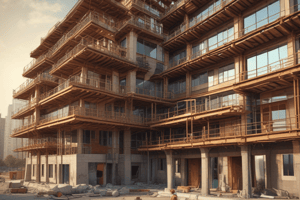Podcast
Questions and Answers
What are preliminary cost estimates?
What are preliminary cost estimates?
Estimates of future construction expenditures made during project planning and design phases.
Final cost estimates are prepared when finalized working drawings and specifications are ready.
Final cost estimates are prepared when finalized working drawings and specifications are ready.
True (A)
Which factors influence the accuracy of a final cost estimate?
Which factors influence the accuracy of a final cost estimate?
- Quality of cost data available
- Similarity of activities to contractor's experience
- Expertise of the estimator
- All of the above (correct)
What does the estimator need to do for labor cost estimation?
What does the estimator need to do for labor cost estimation?
What are indirect labor costs?
What are indirect labor costs?
What must be considered when estimating equipment costs?
What must be considered when estimating equipment costs?
What is the role of subcontractor bids in estimating?
What is the role of subcontractor bids in estimating?
What does project overhead refer to?
What does project overhead refer to?
Study Notes
Preliminary Cost Estimates
- Approximate estimates of construction costs are made during planning and design phases when projects are still not fully defined.
- Project costs are refined continuously during the design phase after each design change to stay within the owner's budget.
Final Cost Estimate (Contractor's Estimate)
- Completed once working drawings and specifications are finalized.
- Detailed estimates depend on comprehensive surveys of work quantities needed for construction.
- Accuracy hinges on factors like cost data quality, contractor's past experience, project uncertainties, and estimator expertise.
Highway Bridge Estimate Components
- Bid forms are required, both blank and completed.
- Quantity surveys identify necessary materials and labor.
- Pre-bid meetings review project scopes with management.
- Field supervision requires a chart with titles, names, and experience.
- Construction method studies finalize approaches and timelines.
- General time schedules outline the project master plan.
- Equipment decisions include identification of type and source and summary sheets for costs.
- Labor costs are categorized into direct and indirect expenses.
Labor Costs
- Estimators must conduct thorough job analyses and access historical unit costs and production rates.
- Direct labor costs calculated from production quantities and rates, while indirect labor covers additional expenses like payroll taxes and benefits.
Equipment Cost Estimating
- Equipment involves all contractor's tools and machinery used for construction projects.
- Significant portion of costs arise from equipment—especially for engineering projects as opposed to buildings.
- Major equipment requires detailed study regarding size, type, and operational needs; decisions on ownership, leasing, or renting are crucial.
- Operating costs encompass maintenance and usage expenses, excluding operator wages.
Basis for Equipment Cost Estimating
- Equipment expenses include ownership/lease/rental costs (often monthly) and operational costs based on project work quantities.
- A total equipment charge may be calculated per unit time.
- Mobilization and demobilization costs are tracked separately but included in the bid.
Subcontractor Bids
- Estimators solicit bids from subcontractors for specialized work through detailed drawings and specifications.
- Evaluation of subcontractor bids is critical, with quality and understanding of work being as important as cost.
- Unsolicited proposals may be considered against prime contractor estimates for cost advantages.
Overhead
- Overhead constitutes indirect expenses that cannot be allocated to specific work items.
- Project overhead includes job and field overhead, with small projects typically seeing overhead charged as a percentage of direct costs.
Studying That Suits You
Use AI to generate personalized quizzes and flashcards to suit your learning preferences.
Related Documents
Description
This quiz explores the various aspects of cost estimates related to construction projects, highlighting the differences between preliminary and final estimates. It covers key components such as quantity surveys, bid forms, and the influence of contractor expertise on accuracy. Test your knowledge on the factors and processes involved in effective construction cost estimation.





